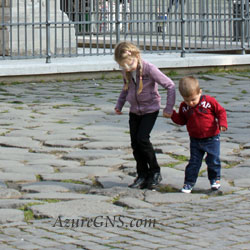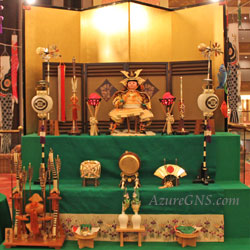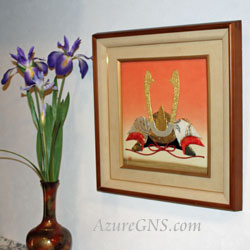国民の祝日
(5月5日)
National Holiday
Kodomo-no-hi
Children’s Day
(May 5th)
●こどもの日 Kodomo-no-hi; Children’s Day
●祭り festival; (正式、祝いの催し)festivity
●祝い celebration
●成長 growth
●健康 health
●強さ strength
●鯉のぼり Koi-nobori: carp-shaped colorful streamers
●武者人形 warrior doll
●かぶと helmet
●よろい armor; 【英Br.】armour
●刀 sword
●鯉 carp
●菖蒲 iris
◆5月5日はかつて端午の節句と呼ばれ、男の子の強く健やかな成長を祈願してさまざまな行事が行われました。
May 5th used to be called Tango-no-sekku, and on this day people prayed that their boys would become strong and healthy, and held various events.
◆1948年(昭和23年)に5月5日は国民の祝日のこどもの日となり、今では公式に男女両方の成長を祝う日です。
In 1948 (Showa 23rd yr), May 5th was designated as a national holiday, Kodomo-no-hi, Children’s Day, for the official celebration of both boys’ and girls’ growth.
◆しかし、現在でも各家庭では、3月3日が女の子の節句であるのに対して、5月5日は男の子の節句として祝われ、特に初節句は盛大に行われます。
However, at home, May 5th is still considered to be a holiday for boys, and especially the first Tango-no-sekku is gorgeously celebrated; and on the other hand, girls’ celebration is held on May 3rd.
◆こどもの日の趣旨は「こどもの人格を重んじ、こどもの幸福をはかるとともに、母に感謝する」ということです。
The purpose of Kodomo-no-hi is “to value the personalities of children, to consider their happiness, and to thank their mothers.”
◆家の中に強さの象徴であるかぶとの飾りや武者人形、または金太郎(怪力、強健で、成長後に出世した子供)や武蔵坊弁慶(怪力無双で忠義に篤い僧兵)のような五月人形を飾ります。
A decorative warrior’s helmet and a warrior doll or gogatsu-ningyo (literally “May doll”) of Kintaro (a very healthy boy with superhuman powers, who was promoted when growing up) or Musashibo Benkei (a loyal warrior monk with unrivaled physical strength) are displayed in the house as the symbol of strength.
◆屋外には鯉の形をした色鮮やかな吹流し、鯉のぼりを長い竹竿に付けて立てます。
Outdoors, Koi-nobori, carp-shaped colorful streamers are attached to a tall bamboo pole.
◆中国には鯉は黄河をさかのぼり竜になるという伝説があるので、鯉は強さと出世の象徴と考えられています。
According to a Chinese legend, carp swim up the Yellow River and then turn into dragons; therefore, carp have become a symbol of strength and success.
◆伝統的にこどもの日にはちまきや柏餅などの和菓子を食べます。
Japanese sweets, chimaki and kashiwa-mochi are traditionally eaten on Kodomo-no-hi.
◆ちまきは竹の葉で包み、イ草で縛った蒸し餅です。
The chimaki is a steamed rice cake wrapped in bamboo leaves and bound with igusa (Japanese soft rushes).
◆柏餅は餅に漉し餡、粒餡、味噌餡などを入れ、柏の葉で包んだものです。
Kashiwa-mochi is a rice cake stuffed with sweet bean paste and wrapped in an oak leaf.
◆柏餅の起源は江戸時代(1603-1867)中期で、柏の葉は葉守の神(はもりのかみ)が宿るとされ、柏の木は新芽が出てから古い葉が落ちるため子孫繁栄に縁起が良いとされています。
Kashiwa-mochi originated in the middle of the Edo period (1603-1867), and Hamori-no-kami (a leaf-protect god) is believed to live on a leaf of Kashiwa (oak), and it is considered to be a lucky tree for prosperity of descendants because old oak leaves fall after new buds come out.
◆端午の節句は菖蒲の節句とも呼ばれ、5月に咲く菖蒲はこどもの日を象徴する花です。
Tango-no-sekku is also called Shobu-no-sekku, a Festival of Irises, which are in bloom in May, and an iris is considered to be a symbol flower of Children’s Day.
◆武士の時代になった鎌倉時代、漢字は異なりますが、菖蒲は「尚武」や「勝負」と同じ読み方をするために好まれました。
In the Kamakura Period, a warrior’s age, shobu (iris) was appreciated because shobu also meant “martial spirit” and “fight” due to differences of Kanji characters (Chinese characters).
◆そして細長い葉は武士の刀の形に似ているため、男子を守ると考えられました。
Their linear leaves are similar to the shape of a warrior’s sword; therefore, they were thought to protect boys.
◆菖蒲の葉を入れたお風呂の湯は薬効があるため、子供が入ると武士のように強くなり、悪運を払うと言われています。
A hot bath with iris leaves has a medicinal effect, so it is believed that taking an iris-leaf bath makes children strong like warriors and drives away evil spirits.
(より詳しい情報は「我が家のこどもの日」をご覧下さい。)
(Please see “My Children’s Day Experience” for further information.)
Copyright (C) Azure Global Network Services. All Rights Reserved.






